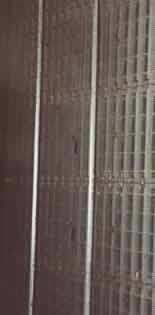
Product: ESL-989 electrostatic loudspeaker
Manufacturer: Quad - UK
Approximate price: e7000 (UK), e9000 (export markets)
Test sample: auditioned at dealer's (multiple sessions)
Reviewer: Werner Ogiers
I my recent review of the Quad ESL-989 electrostatic loudspeaker I detected a strange hardness on vocals, mostly during loud peaks in the music. I promised to investigate this phenomenon further.
I contacted Quad directly, but as this was around the London Hifi Show they were too busy to get back and comment in some detail. Not really a problem: whatever their words would be, the sound of the speaker wouldn't change, would it?
So I amassed more listening experience with the ESLs. This time the system used was a full Quad 99 stack, with the 909 140W stereo power amplifier. These electronics sound decidedly less transparent than the Trichords used before - or even the Quad IIs, for that matter - and they cast a slight darkish veil over the sound, adding some electronic colourations. Yet, while we actually know that the 989 was designed for the new Quad II-forty and SC-24 valve amps - or vice versa - it seems reasonable to assume that a 99/99/909 setup was also one of the design systems at Quad's development facilities. Hence, the system used now should yield a sound akin to what the designers intended.
Apart from the system-caused aberrations from true fidelity outlined above, the new listening experience was - again - mostly an excellent one: within seconds I found myself relaxing to the sounds of Tracy Chapman's first, and I duly forgot that I was supposed to do some stern reviewing work.
The midrange was still a bit pronounced, making things a bit forward, but the on/off hardening heard before seemed almost totally gone. Treble was now a mite dry, though, but I'd attribute that to the system.

So what's happening here? Well, for sure I was now playing at lower levels than during the first listening sessions. You see, with its majectic and extended bass its reference-class clarity and its utterly unmatched headphones-like coherence, the ESL-989 invites you to play loud. And that is a feat that it, in fact, can't quite accomplish. Which is logical: the mid-section of the speaker still is equivalent to an old ESL-63, and thus must inherit the same limitations as its venerable predecessor had. So backing off the volume and reigning in your instincts is a cure.
More: break-in plays a role too. I heard the speakers in three session groups placed days after delivery, after two weeks, and now after five weeks. Weeks of continuous use, mind that. During that time the ESLs softened a lot. In the final sessions, I could make reference to a - literally - new-out-of-the-box pair of the smaller ESL-988s: while of course less weighty than the 989s, they surely sounded a lot harder too. So a long run-in period is mandatory, and check this at your dealer when going for a demonstration.
High quality tube electronics are probably mandatory too.
And a good source. During all of the listening tests I had the feeling that at least some of the problems were due to the raw exposure of the CD standard now. The ESL-989s are very revealing and really demand that everything in front of them be first class. (Which doesn't mean that you can only play audiophile software. Heck, I never listen to such amusical crap!)
So, my final recipe, although not completely verified: tubes, vinyl, a good room, a bunch of tubetraps, some self-control, and a lot of patience. I still find this one of the most fascinating and promising high-cost speakers I have encountered so far, but it surely needs a lot of work to get it right.
© Copyright 2000 Werner Ogiers - https://www.tnt-audio.com